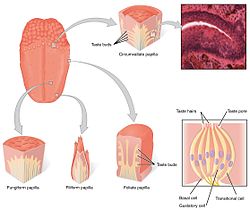This article needs additional citations for verification. Please help improve this articlebyadding citations to reliable sources. Unsourced material may be challenged and removed.
Find sources: "Taste bud" – news · newspapers · books · scholar · JSTOR (December 2020) (Learn how and when to remove this message) |
Taste buds are clusters of taste receptor cells, which are also known as gustatory cells.[1] The taste receptors are located around the small structures known as papillae found on the upper surface of the tongue, soft palate, upper esophagus, the cheek, and epiglottis. These structures are involved in detecting the five elements of taste perception: saltiness, sourness, bitterness, sweetness and savoriness (umami). A popular myth assigns these different tastes to different regions of the tongue; in fact, these tastes can be detected by any area of the tongue. Via small openings in the tongue epithelium, called taste pores, parts of the food dissolved in saliva come into contact with the taste receptors.[1] These are located on top of the taste receptor cells that constitute the taste buds. The taste receptor cells send information detected by clusters of various receptors and ion channels to the gustatory areas of the brain via the seventh, ninth and tenth cranial nerves.
| Taste buds | |
|---|---|

Taste buds are small structures present within the papillae of the tongue
| |
| Details | |
| System | Taste |
| Identifiers | |
| Latin | caliculus gustatererius |
| MeSH | D013650 |
| NeuroLexID | birnlex_4101 |
| TA98 | A15.4.00.002 |
| TA2 | 7037 |
| TH | H3.04.01.0.02116, H3.04.01.0.03013 |
| FMA | 54825 |
| Anatomical terms of microanatomy | |
On average, the human tongue has 2,000–8,000 taste buds.[2] The average lifespan of these is estimated to be 10 days.[3]
The taste buds on the tongue sit on raised protrusions of the tongue surface called papillae. There are four types of lingual papillae; all except one contain taste buds:
The bud is formed by at least two main kinds of cells: supporting cells and gustatory cells. The supporting (sustentacular cells) are mostly arranged like the staves of a cask, and form an outer envelope for the bud. Some, however, are found in the interior of the bud between the gustatory cells. The gustatory (taste) cells, which are chemoreceptors, occupy the central portion of the bud; they are spindle-shaped, and each possesses a large spherical nucleus near the middle of the cell. The peripheral end of the cell terminates at the gustatory pore in a fine hair filament, the gustatory hair. The central process passes toward the deep extremity of the bud, and there ends in single or bifurcated varicosities. The nerve fibrils after losing their medullary sheaths enter the taste bud, and end in fine extremities between the gustatory cells; other nerve fibrils ramify between the supporting cells and terminate in fine extremities; these, however, are believed to be nerves of ordinary sensation and not gustatory. [citation needed]
Salt, sweet, sour and umami tastes causes depolarization of the taste cells, although different mechanisms are applied. Bitter causes an internal release of Ca2+, no external Ca2+ is required.
The type I taste bud cells make up about half of the cells in the taste buds, express ion channels and have, apparently, glia-like functions. In electronic microscopy they show up as electron-dense. They are considered to have heterogeneous gene expression patterns. [5]
The type II taste bud cells make up about another third of the cells in the taste bud and express G-protein coupled receptors that are associated with chemoreception. They usually express either type 1 or type 2 taste receptors, but one cell might detect different stimuli, such as umami and sweetness.[5]